Blog - General
Dave’s April Bird Chatter
April is another exciting month for bird migration, and maybe, one of the most productive. Purple Martins will be arriving along with Brown Thrashers, Catbirds, and the beloved Orioles. Others will begin their passage through Nebraska and the Central Great Plains. Early warblers, Kinglets, and a vast number of shorebirds will be on the move. More than 36 species of shorebirds pass through 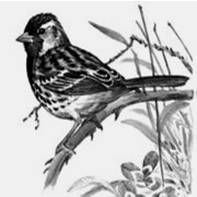 Nebraska to northern breeding grounds with some species remaining to nest within the state. Native sparrows will begin to appear including one of my favorites, the Harris’ Sparrow. They will be in route to the Boreal Forests of Canada. Many native sparrows will return to Nebraska to nest. The Grasshopper Sparrow, Henslow, Lark, and Savannah Sparrows, just to name a few. A variety of native sparrows nest on the ground in the grasslands of the Great Plains. But the continued expansion of crop production fueled by the Ethanol industry is putting tremendous pressure on their population as it is for many other grassland bird species such as Long-billed Curlews and Prairie Chickens. But just as our summer birds begin to reappear, our winter visitors from the north will disappear. By months end the Pine Siskin, Red Polls, Juncos and others will be on their way north to their summer range. The migration will continue into early June and then as early as mid-August, many of these birds will be headed back south for the winter. This is a great time to buy a good field guide to identify the birds that will be passing through or setting up house keeping in your yard. Make it a point to visit some of the natural areas such as Wilderness Park, Spring Creek Prairie, or the Pioneers Park Nature Center and look for birds to add to your list. The MoPac Trail in Lincoln is an excellent place where you might even be treated to a glimpse of a Scarlet or Summer Tanager. Go out and enjoy the migration.
Nebraska to northern breeding grounds with some species remaining to nest within the state. Native sparrows will begin to appear including one of my favorites, the Harris’ Sparrow. They will be in route to the Boreal Forests of Canada. Many native sparrows will return to Nebraska to nest. The Grasshopper Sparrow, Henslow, Lark, and Savannah Sparrows, just to name a few. A variety of native sparrows nest on the ground in the grasslands of the Great Plains. But the continued expansion of crop production fueled by the Ethanol industry is putting tremendous pressure on their population as it is for many other grassland bird species such as Long-billed Curlews and Prairie Chickens. But just as our summer birds begin to reappear, our winter visitors from the north will disappear. By months end the Pine Siskin, Red Polls, Juncos and others will be on their way north to their summer range. The migration will continue into early June and then as early as mid-August, many of these birds will be headed back south for the winter. This is a great time to buy a good field guide to identify the birds that will be passing through or setting up house keeping in your yard. Make it a point to visit some of the natural areas such as Wilderness Park, Spring Creek Prairie, or the Pioneers Park Nature Center and look for birds to add to your list. The MoPac Trail in Lincoln is an excellent place where you might even be treated to a glimpse of a Scarlet or Summer Tanager. Go out and enjoy the migration.
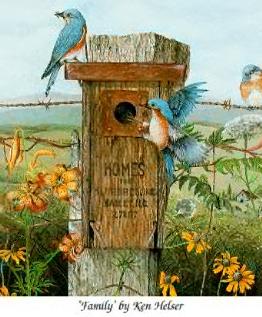
April is the month when Bluebirds get serious about nesting. If you live in rural areas, or in some of the outlying edges of the city you may want to consider putting up a couple of nest boxes for Bluebirds. At Wild Bird Habitat we have all the information you need, carry a variety of Bluebird nesting boxes, and can consult with you about the potential of attracting them where you live. You can also visit Bluebirds Across Nebraska’s website at: bbne.org. Many folks have spotted numerous Bluebirds around the area and the males, with their bright blue feathers and orange breasts, are a certain sign that spring has arrived.
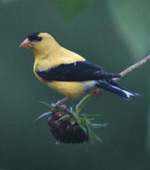 The Goldfinches that moved south for the winter have returned to join those that have been at our feeders over the past few months. Their numbers can become overwhelming at times as they raid our thistle feeders. If you did not have many Goldfinches at your feeders during the winter, you should have plenty of them now. The coating of olive drab, which covered the bright golden feathers of the males during the winter months, will be warring off and they will become that bright canary yellow that makes them so attractive to have around. There is still a good population of Pine Siskins at the thistle feeders, but enjoy them now. They will soon be headed north for the summer.
The Goldfinches that moved south for the winter have returned to join those that have been at our feeders over the past few months. Their numbers can become overwhelming at times as they raid our thistle feeders. If you did not have many Goldfinches at your feeders during the winter, you should have plenty of them now. The coating of olive drab, which covered the bright golden feathers of the males during the winter months, will be warring off and they will become that bright canary yellow that makes them so attractive to have around. There is still a good population of Pine Siskins at the thistle feeders, but enjoy them now. They will soon be headed north for the summer.
Gardening and birding are the two number #1 outdoor recreational activities in the United States. So why not combine both of these popular activities and landscape for wildlife? It will not only benefit wildlife and birds by providing; natural foods, a site to raise a family, 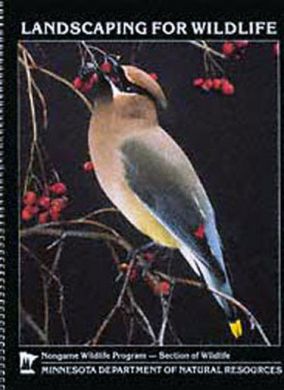 and shelter from uninviting weather and predators, but it will benefit you as well. Landscaping can be a family project, increase the value of your property, and conserve home energy consumption by blocking cold northern winds in winter and providing shade during summer from the hot sun. It may sound like an enormous and costly project, but it can be as simple and inexpensive as planting one or two shrubs every spring. Maybe start a butterfly or hummingbird garden. Start simple and in just a few years you’ll be surprised at the result of what you have created, and the benefit it provides the birds in your backyard. Carroll Henderson’s popular publication, “Landscaping for Wildlife”, available at the Wild Bird Habitat Stores, takes the guess work out of designing wildlife habitat from a small yard, to acreages, to farm ground. The information is very detailed, yet easy to follow, and is specific to the upper Midwest and Central Great Plains. My advice for those in newly developed areas is to select shrubs that benefit wildlife. They mature in three to five years where as trees can take a decade or more. My favorite wildlife shrubs? Service Berry, Black Choke Berry, and Arrow Viburnum.
and shelter from uninviting weather and predators, but it will benefit you as well. Landscaping can be a family project, increase the value of your property, and conserve home energy consumption by blocking cold northern winds in winter and providing shade during summer from the hot sun. It may sound like an enormous and costly project, but it can be as simple and inexpensive as planting one or two shrubs every spring. Maybe start a butterfly or hummingbird garden. Start simple and in just a few years you’ll be surprised at the result of what you have created, and the benefit it provides the birds in your backyard. Carroll Henderson’s popular publication, “Landscaping for Wildlife”, available at the Wild Bird Habitat Stores, takes the guess work out of designing wildlife habitat from a small yard, to acreages, to farm ground. The information is very detailed, yet easy to follow, and is specific to the upper Midwest and Central Great Plains. My advice for those in newly developed areas is to select shrubs that benefit wildlife. They mature in three to five years where as trees can take a decade or more. My favorite wildlife shrubs? Service Berry, Black Choke Berry, and Arrow Viburnum.
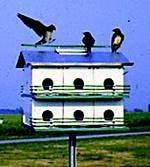 Do you have the habitat for Purple Martins? Have you failed to attract Martins to your Martin house? Wild Bird Habitat can help. We will consult with individuals to make certain you have the potential to attract these highly sought after birds. We will not sell a Purple Martin house for the sake of making a sell. We want you to be successful. For a small fee we will even assemble and install Purple Martin houses. That said, it is time to get ready for these swallows, the largest of the family. Purple Martins that arrive early are often considered “scouts”. Most often these are adults with prior nesting experience that arrive early, most already having established colonies. The majority of Martins that start new colonies are immature birds that begin arriving in early April and will continue to arrive throughout the month. We have installed numerous houses as late as the third week of April with Martins establishing a new colony shortly thereafter. Want to know more? Contact Dave at the Lincoln Wild Bird Habitat Store. At Wild Bird Habitat you’ll find a complete line of Purple Martin Houses, accessories, and replacement parts.
Do you have the habitat for Purple Martins? Have you failed to attract Martins to your Martin house? Wild Bird Habitat can help. We will consult with individuals to make certain you have the potential to attract these highly sought after birds. We will not sell a Purple Martin house for the sake of making a sell. We want you to be successful. For a small fee we will even assemble and install Purple Martin houses. That said, it is time to get ready for these swallows, the largest of the family. Purple Martins that arrive early are often considered “scouts”. Most often these are adults with prior nesting experience that arrive early, most already having established colonies. The majority of Martins that start new colonies are immature birds that begin arriving in early April and will continue to arrive throughout the month. We have installed numerous houses as late as the third week of April with Martins establishing a new colony shortly thereafter. Want to know more? Contact Dave at the Lincoln Wild Bird Habitat Store. At Wild Bird Habitat you’ll find a complete line of Purple Martin Houses, accessories, and replacement parts.
